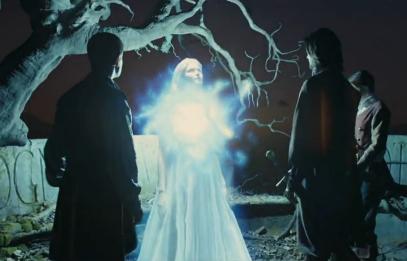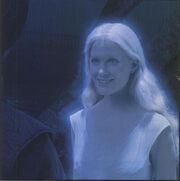
The Star Lilliandil.
Stars (or Star People) were an innately magical species of sentient beings found in the World of Narnia. They exist in celestial bodies, except for occasional periods of rest on the surface in humanoid bodies, and other special circumstances.
History[]
Stars were the first things created by Aslan's song at the dawn of time, and they immediately joined him in his song. They appeared fully formed in the sky, in constellations and individual positions.
Stars were seen in their sky form throughout their existence, and were also briefly encountered in human form while at rest.
At the end of the world, the stars were called to earth by Father Time. After falling as shooting stars, they entered Aslan's country through the "stable door" on Stable Hill.
Description[]
Stars' precise form in the sky was unclear, though it was evident that they could see and think like humans, making them sentient beings rather than mere gaseous celestial objects (like the stars seen from Earth). This is the form, however, that stars took for the majority of the time. It was possible that stars in the sky also had a somewhat human appearance, though it was impossible to tell their true appearance beyond the tremendous amount of blinding light they emitted.
Some stars spent time in fully human form, in which they did not emit light or heat, but looked and behaved like most human beings. This was not a normal occurrence, and few fully human stars were seen in the World of Narnia. It is believed that stars could naturally exist in these human bodies under two circumstances. First, if stars were extremely old (possibly thousands of years) to the point of losing their celestial power, they would fall to the Eastern Ocean where, waiting on one of its many islands, they could gradually recover their powers over long spans of time (specifically by the daily consumption of fire-berries). For stars, this recuperation period while in human form was known as "retirement", though it was only temporary until the star regained enough strength to rise into the sky once more. Second, if a star had committed some crime, Aslan could assign the star some earthly duty as punishment, in which the star would also take a human form.
During Caspian X's voyage, only two stars in human form were ever seen (both male). The first was Coriakin, who was banished from the sky to govern the Duffers as punishment. He appeared fully human, but had magical information at his disposal. The second was Ramandu, who lived in retirement, with his human daughter, on his own private island. He seemed to have light coming from him, and thus could be interpreted to be more star-like than Coriakin.
Ramandu's retirement was not indefinite. Every morning, he was brought a fire-berry from the sun, which made him a day younger. He said that when he became as young as a child born yesterday, he would return to the sky, once more in a star form.
Another human appearance was at the end of the world, when the Stars were called out of the sky by Father Time. They appeared in a very bright human form.
Stars at Rest[]
Stars at rest take a humanoid form. The only known star met in such a condition was Ramandu.
Children[]

Ramandu's daughter.
It was possible for stars, in human form, to have human mates and to produce human children. The only known child of a star was Ramandu's daughter.
It is not known who her mother was (or if she had one at all). Thus, she was either the child of Ramandu and a human, or a female star (though she only ever existed in human form until her death, suggesting that she was not a star, but rather, fully human, for Stars are immortal), or was somehow produced by him without a wife.
Ramandu's daughter eventually married King Caspian X of Narnia, and was the mother of King Rilian, and ancestress of all Narnia's subsequent monarchs.
Astronomy and Astrology[]
Both astronomy and astrology were practiced in Narnia.
Astronomy was well known, particularly among nobility, and the positions of stars and constellations were studied by Narnians, who knew about human stars, as well as by Telmarines, who did not.
Centaurs studied the stars astrologically, and made prophecies based upon their positions. The prophecies were accurate.
Comparison with Other Celestial Objects[]
Stars were very distinct from other celestial objects in the World of Narnia.
The Sun of Narnia was not a star. This was obvious right from its creation, when it appeared far brighter than the stars. It is also evident that the Sun is not a person (like the stars), but a place. (It is often mentioned that the sun has terrains and climates.)
Another difference between it and the stars at that point was that the sun did not sing. Another implication occurred when Father Christmas said Lucy's Cordial came from fireflowers in the mountains of the sun. A similar reference was later, during Caspian's Voyage, when the birds carrying Ramandu's fireberry were said to have come directly from the sun. Later in the voyage, the sun could be seen past the edge of the world, presumably in Aslan's country. Stars, in contrast, were evidently within the World of Narnia. Finally, at the end of the world, the sun did not get called to earth by Father Time with the stars. Instead it became "old" and red, like the sun in Charn, before eventually fading altogether.
The sun in Narnia rose in the east and set in the west, as was evidenced by Narnia being flat, but it was also mentioned to have an end, which is Aslan's Country.
Planets existed in Narnia, but were considered comparable to stars in their sky form, instead of being compared to Narnia.
Known Stars and Constellations[]
Stars[]
- Alambil, the Lady of Peace
- Aravir, the morning star
- Coriakin
- Ramandu
- Ramandu's daughter
- Spear Head, the Pole Star
- Tarva, the Lord of Victory
Constellations[]
The Ship, Leopard, and Hammer were constellations seen in the summer skies of Narnia. Lucy's favourite constellation was the Leopard.
- The Hammer
- The Leopard
- The Ship
